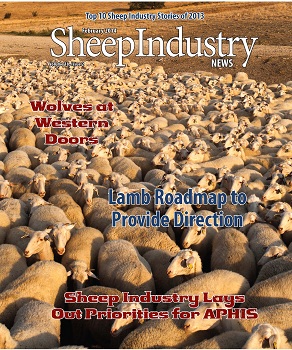
- February 2014
- President’s Notes
- Market Report
- American Lamb Industry Announces Final Roadmap
- Looking Back: Top 10 Sheep Stories of 2013
- Sheep to Shawl
- Sheep Growing Senator Weighs in on Idaho Wolf Debate
- Are Your Ewes Pregnant?
- Economist Sees Bumpy Years for U.S. Ag
- New Farm Bill May Bring Insurance Issues
- New Wool Yarn Mill Filling Niche
- College Wool Judging Teams Pick Up Skills Together at Belle Fourche Clinic
- ASI Offers Sheep Priorities to APHIS
- Utah Farm Bureau: States Can Manage Wolves
- Farmland Prices Rise, But How Long is Ride?
- Sheep Heritage Contributors
- Obituaries
New Farm Bill May Bring Insurance Issues
WASHINGTON –After more than three years of deliberations on the Farm Bill, it finally appeared in late January that the leadership of the Senate and House Agriculture Committees were getting close to reaching a deal.
Producers are very likely to be given a commodity title safety net choice between the Senate’s Agriculture Risk Coverage (ARC) and the House’s Price Loss Coverage (PLC) for each covered commodity on their operations. Quite a bit of rhetoric during the farm bill debate focused on which of the two choices is better for the future of U.S. Agriculture.
Once the bill is passed, all the rhetoric is just that and producers will be faced with real questions regarding their choices. This means that producers will need to evaluate both ARC and PLC for each crop on each of their farms and decide which option provides the safety net that they would be the most comfortable with over the next five years. Unfortunately, no one knows exactly where prices are going for sure, but evaluating each choice across a wide range of potential price levels is going to be essential.
In addition to the commodity program choice provided by the bill, federal crop insurance legislation is likely to be adjusted to allow producers to purchase an area-wide policy on top of their normal buy-up coverage. The Supplemental Coverage Option (SCO) was designed to help cover a portion of the losses that would typically be in the range of a producer’s deductible. SCO is expected to have a slightly higher subsidy rate than current buy-up insurance, making it a relatively inexpensive option.
Producers will have the option to purchase SCO on top of their typical buy-up coverage or change their buy-up coverage level and purchase SCO, or, although very unlikely, just purchase SCO and no buy-up coverage. We feel this last option is very unlikely because most producers across the U.S. already have the option to purchase some type of area-wide policy instead of revenue or yield buy-up insurance and very few do. Issues with area-wide insurance tools arise when the county may not trigger a loss when the producer did suffer a significant loss.
However, in situations where producers have very poor APH yields buying lower levels of buy-up and SCO could offer roughly the same protection at a lower cost. Producers will need to give these choices careful consideration and evaluation before meeting with their crop insurance professional.
Producers will need to evaluate these two significant changes in the next farm bill thoroughly before signing up with FSA and purchasing their crop insurance.
With lower commodity prices forecasted for the next few years, producers will be well advised to consider the amount of protection that is and is not provided by each of these alternatives.
Reprinted from the Southwest Farm Press

